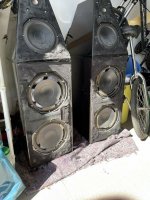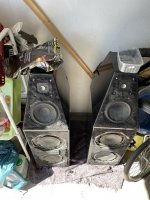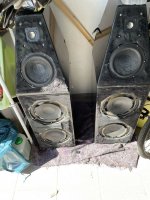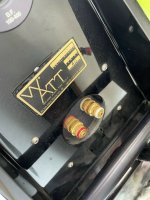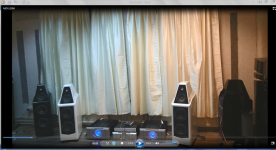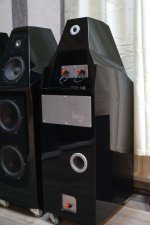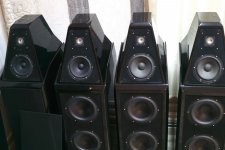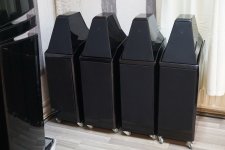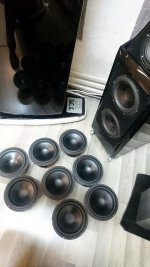A bit unrelated but does anyone know how different is the 18W4545-01 (M-5022) from the 4545-03 which seems easily available? Datasheet? It seems the 01 version is available under the 8545, should i assume similar T/S?
These questions are just to ascertain whether the 03 may work as a reasonable approximation for a 01, or is an authentic M-5022 the only option. Obviously both channels will need to be replaced.
Any advice will be appreciated.
These questions are just to ascertain whether the 03 may work as a reasonable approximation for a 01, or is an authentic M-5022 the only option. Obviously both channels will need to be replaced.
Any advice will be appreciated.
Where you have this discover ?I don't know that I'd want to duplicate the v1 crossover. It had a nasty impedance drop to something like 1.5 ohms in its response.
I don't find it online.
an interesting offer from Germany: Dynaudio bass drivers - new foam surrounds necessary
Wilson Audio Tiny Tot - Watt Audio - Schwarz in Hessen - Ranstadt | Lautsprecher & Kopfhorer gebraucht kaufen | eBay Kleinanzeigen
Wilson Audio Tiny Tot - Watt Audio - Schwarz in Hessen - Ranstadt | Lautsprecher & Kopfhorer gebraucht kaufen | eBay Kleinanzeigen
Attachments
Last edited:
A bit unrelated but does anyone know how different is the 18W4545-01 (M-5022) from the 4545-03 which seems easily available? Datasheet? It seems the 01 version is available under the 8545, should i assume similar T/S?
These questions are just to ascertain whether the 03 may work as a reasonable approximation for a 01, or is an authentic M-5022 the only option. Obviously both channels will need to be replaced.
Any advice will be appreciated.
cone glue, slight diferent basket holes, diferent VC former material and diferent VC lenght.
Let me get straight the idea of the shot w.a.t.t. ad? Buyer will receive 29 hundred euro to collect these?
new foam surrounds necessary
Foam? These were rubber as far as i know. How did they get into this sorry state? At least someone had the sense to put in sensible termination in place of the factory crap.
cone glue, slight diferent basket holes, diferent VC former material and diferent VC lenght.
Thanks. I figured out the VC was different but the rest is news to me.
When I was really young i reverse engineered WP6 and wp8, got all the original drivers(pretty expensive thought at that time) those are very "rought" sounding in uper mids. when I still was young and more challenge oriented i reverese engineered Sasha WP, around 10 pair of those or so. again with original drivers, except mids, where i build drivers by myself. those are much better speakers than WP. To clone or reverse engineer speakers there is a lot more than recreate frequency and driver slopes.
Attachments
here is sasha mid driver disasembled(on the left) quite diferent SD from usual implementations.
bass drivers have 4 layers VC and are much heavier than its older siblings from dynaudio. bass is cleaner, more punchy and handlle nearly double the power before going to compression or overexcursion comapring to "1000W'' 21w45 version.
bass drivers have 4 layers VC and are much heavier than its older siblings from dynaudio. bass is cleaner, more punchy and handlle nearly double the power before going to compression or overexcursion comapring to "1000W'' 21w45 version.
Attachments
Last edited:
I don't know about the owner. But I am sure, that Dynaudio uses not only rubber surroundsFoam? These were rubber as far as i know. How did they get into this sorry state? At least someone had the sense to put in sensible termination in place of the factory crap.
Dynaudio Lautsprecher Reparatur
WP up to model 6 had dynaudio based woofers with foam surrounds. 7,8 and sasha wp had scan speak based woofers which have rubber surrounds. Foam surrounds on WP lasts 7 to 13 years depending on how much UV they see. keeping grills in place helps a bit.
maybe the most effective step to realize Bi-amping is the introduce of an active low pass active crossover and remove the passive part for both bass transducers. One amp drives the transducers of "PUPPY" chamber and the second amp (ideally a class-A single ended) drives the "WATT" unit, perhaps with an active 6db crossover network (just a correctly sized capacitor at the power amp input).
Hey Hi! I worked at Wilson in the 90s (building crossovers and speakers) and while I won't tell you specific details, I will tell you that duplicating the crossover network would be next to impossible. They do some wonky(but really cool) things inside and the caps and inductors are measured with extreme precision. Even building crossovers, we never had diagrams or schematics to go from. They're very tight lipped about the numbers because it's their secret sauce - that's why they pot them. They modify stock drivers, they use custom materials for the cabinets, but when it comes to the crossovers, they use off the shelf products, arranged in a certain way to make the magic happen. The head engineer is one of the smartest men I've met. To get the Wilson experience, you have to pay the Wilson price. HOWEVER... you could get awfully close to the magic if you build your own second/third level crossovers and get a sound you'd likely be very happy with. It's no ONE thing with Wilson (or any other high end speaker manufacturer). It's a tweak here, a tweak there, a port tune over there and a weird capacitor here. In the end, it's electronics. Do the math, use the calculators for the frequency rolloffs you want, and then experiment!
As stated. By Wilson Dude. ..Unless you have seen or been into a Watt crossover.. it’s something that no DIY WILL GET.. nor figure out ..Hey Hi! I worked at Wilson in the 90s (building crossovers and speakers) and while I won't tell you specific details, I will tell you that duplicating the crossover network would be next to impossible. They do some wonky(but really cool) things inside and the caps and inductors are measured with extreme precision. Even building crossovers, we never had diagrams or schematics to go from. They're very tight lipped about the numbers because it's their secret sauce - that's why they pot them. They modify stock drivers, they use custom materials for the cabinets, but when it comes to the crossovers, they use off the shelf products, arranged in a certain way to make the magic happen. The head engineer is one of the smartest men I've met. To get the Wilson experience, you have to pay the Wilson price. HOWEVER... you could get awfully close to the magic if you build your own second/third level crossovers and get a sound you'd likely be very happy with. It's no ONE thing with Wilson (or any other high end speaker manufacturer). It's a tweak here, a tweak there, a port tune over there and a weird capacitor here. In the end, it's electronics. Do the math, use the calculators for the frequency rolloffs you want, and then experiment!
cross overs are predictable. . There is no magic circuit.. it’s how you implement the simple ones.
this I know … they are NOT first order … and phase is key
Last edited:
Hi all - so re: older Watt/Puppies, given their age and assuming capacitor degradation + potted xovers, are these all heading way out of spec & impossible to repair over the near future? Wondering because I just picked up a pair that need all 4 puppy surrounds + tweeters.
Surrounds replacement no problem.
Tweeters will take some patience to find repairable ones, I assume.. (or... these fabric domes, btw, look to measure very similar to the TC120ti's, on paper: https://sbacoustics.com/product/satori-tw29dn-b/ - maybe just live with whatever differences there may be).
But the main question - if xovers can't be updated, is it worth the hassle? Or maybe it would make more sense to just use the cabinets as a starting point for a DIY 3-way design? Thanks for any input, Chip
Surrounds replacement no problem.
Tweeters will take some patience to find repairable ones, I assume.. (or... these fabric domes, btw, look to measure very similar to the TC120ti's, on paper: https://sbacoustics.com/product/satori-tw29dn-b/ - maybe just live with whatever differences there may be).
But the main question - if xovers can't be updated, is it worth the hassle? Or maybe it would make more sense to just use the cabinets as a starting point for a DIY 3-way design? Thanks for any input, Chip
Last edited:
- Home
- Loudspeakers
- Multi-Way
- Schematic of potted crossover network for Wilson's Watt V/Puppy V.1 wanted

